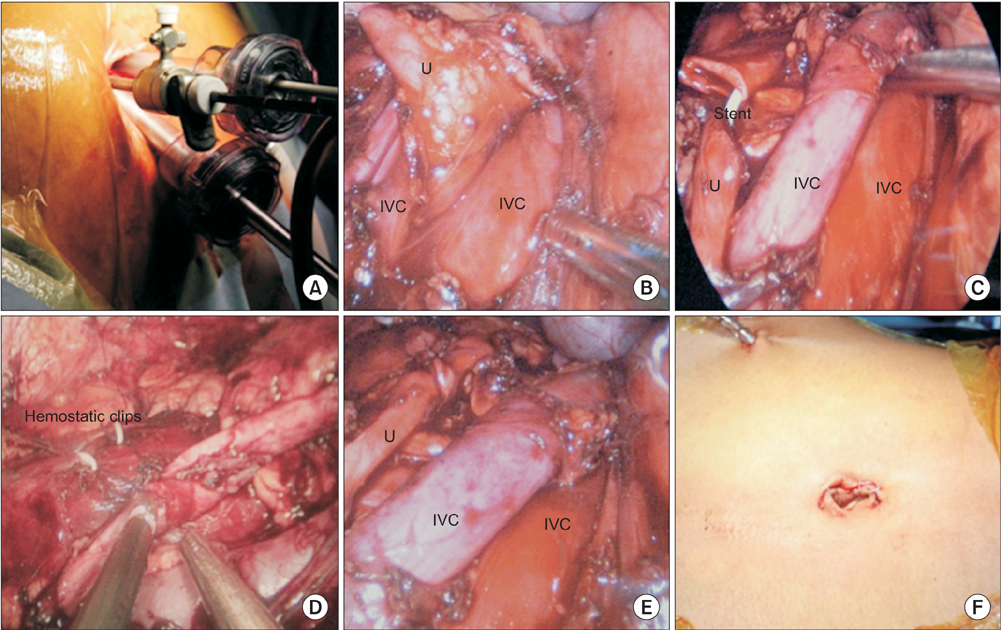Korean J Urol.
2015 Apr;56(4):330-333. 10.4111/kju.2015.56.4.330.
Right sided double inferior vena cava with obstructed retrocaval ureter: Managed with single incision multiple port laparoscopic technique using "Santosh Postgraduate Institute tacking ureteric fixation technique"
- Affiliations
-
- 1Department of Urology, Postgraduate Institute of Medical Education and Research (PGIMER), Chandigarh, India. santoshsp1967jaimatadi@yahoo.co.in
- KMID: 2155310
- DOI: http://doi.org/10.4111/kju.2015.56.4.330
Abstract
- Right double inferior vena cava with obstructed retrocaval ureter is an extremely rare anomaly with only a few reported cases in the literature. To the best of our knowledge, this is the first case report describing ureteric repair by use of a single-incision laparoscopic technique. In addition, this report addresses the underlying surgical challenges of this repair and provides a brief review of the embryology of this anomaly. The "Santosh Postgraduate Institute ureteric tacking fixation technique" provides ease of end-to-end uretero-ureteric anastomosis in a single-incision laparoscopic surgery.
Keyword
MeSH Terms
-
Humans
Intraoperative Care/methods
Intraoperative Complications/*prevention & control
Laparoscopy/methods
Magnetic Resonance Imaging
Male
*Retrocaval Ureter/diagnosis/physiopathology/surgery
Treatment Outcome
Urography/methods
Urologic Surgical Procedures/*methods
*Vena Cava, Inferior/abnormalities/surgery
Young Adult
Figure
Reference
-
1. Kumar S, Shankaregowda SA, Devana SK, Jain S, Singh SK. Single-incision multiport laparoendoscopic technique to repair retrocaval ureter using the Santosh PGI ureteric tacking fixation technique. Asian J Endosc Surg. 2014; 7:337–341.2. Hochstetter F. Beitrage zur Entwicklungsgeschichte des Venensystems der Amnioten: III. Sauger Morph Jahrb. 1893; 20:542.3. Rubinstein I, Cavalcanti AG, Canalini AF, Freitas MA, Accioly PM. Left retrocaval ureter associated with inferior vena caval duplication. J Urol. 1999; 162:1373–1374.4. Considine J. Retrocaval ureter. A review of the literature with a report on two new cases followed for fifteen years and two years respectively. Br J Urol. 1966; 38:412–423.5. Bass JE, Redwine MD, Kramer LA, Huynh PT, Harris JH Jr. Spectrum of congenital anomalies of the inferior vena cava: cross-sectional imaging findings. Radiographics. 2000; 20:639–652.6. Nagashima T, Lee J, Andoh K, Itoh T, Tanohata K, Arai M, et al. Right double inferior vena cava: Report of 5 cases and literature review. J Comput Assist Tomogr. 2006; 30:642–645.7. Chuang VP, Mena CE, Hoskins PA. Congenital anomalies of the inferior vena cava. Review of embryogenesis and presentation of a simplified classification. Br J Radiol. 1974; 47:206–213.8. Shin M, Lee JB, Park SB, Park HJ, Kim YS. Right double inferior vena cava associated with retrocaval ureter: computed tomographic findings in two cases. Clin Imaging. 2014; 38:353–356.9. Matsuda T, Yasumoto R, Tsujino T. Laparoscopic treatment of a retrocaval ureter. Eur Urol. 1996; 29:115–118.10. Polascik TJ, Chen RN. Laparoscopic ureteroureterostomy for retrocaval ureter. J Urol. 1998; 160:121–122.



